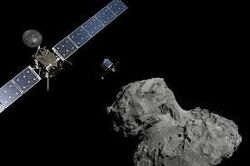UnNews:ESA takes costly colour photos of colourless comet
| Where man always bites dog | ✪ | UnNews | ✪ | Wednesday, December 3, 2025, 18:45:59 (UTC) |
| ESA takes costly colour photos of colourless comet | 
|
13 December 2014
COMET 67P -- Scientists at the European Space Agency (ESA) have been left red-faced after taking three photos of the comet 67P with different filters, only to find out that the seemingly grey comet was actually grey.
Previous photos of the comet had only been taken with the Rosetta space probe's black-and-white cameras, as colour cameras of the day could only take a few pictures in space before running out of oxygen. "Up to this point," commented ESA spokesperson Ariane Espace, "we had assumed that comets were pink with green stripes, but these photos really changed the way we look at comets," rather more than they changed the way comets look.
The Osiris camera was used to take the colour pictures of the comet. Three separate filters, green, red, and blue, were used just to add unnecessary complexity. The camera costs €450,000 and requires a whole team of researchers to operate and set up.
Wiltshire native Esther "Max" Planck offered the ESA her Casio point-and-shoot camera — which has a snappy 8 megapixels, takes color shots as a matter of course, and could be attached to the spacecraft with a few elastics and perhaps actuated by a robot arm — but says she was rebuffed by the ESA.
"How can we be expected to get media attention if we don't stay retro in line with a Stanley Kubrick film?" posed a scientific researcher on the Osiris project as she moved a large pile of floppy disks from one dashboard of flick switches to a Windows 98 machine.
The three pictures taken by Rosetta will be the only three colour pictures taken on the mission and the ESA will return to using black-and-white cameras. In a month's time a smaller probe will detach from Rosetta and travel back to Earth with the next batch of photographic film ready to be developed. As the probe is unmanned, there will be no problem for it to wait outside the shop for five days until prints are ready.
The next piece of equipment to be used on the Rosetta mission is a computer named "HAL". Already critics are claiming that the size of the computer (which takes up the whole spacecraft), its poor interface screen with only one colour available and its inability to speak in a wide range of accents renders the computer "out-of-date by almost 20 years," though it has shown no problems obeying commands.
Sources[edit]
- "Even in colour, Comet 67P is grey". BBC News, December 12, 2014
